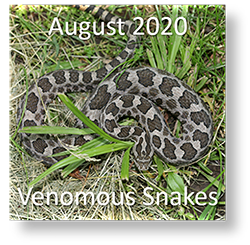
What Are Venomous Snakes? Venom is a toxin for subduing prey. It is delivered through a pair of hollow fangs in the front of the upper mouth. The fangs fold up to the roof of the mouth when the mouth is closed and drop down to be used in biting. Venomous snakes strike their prey, inject venom and pull away. They find and eat the prey after it dies. With this method of hunting, the snake avoids a prolonged battle that could damage its body.
In Illinois, there are four species of venomous snakes.

Photo © Brad M. Glorioso
Photo © Illinois Department of Natural Resources
What Do They Look Like?
Illinois’ venomous snakes are pit vipers. They have a large opening, or pit, on each side of the head between the eye and nostril. Their eyes have an elliptical pupil.
How Big Are They?
total length = the distance along the body in a straight line from the tip of the nose to the tip of the tail
eastern copperhead - up to about 53 inches total length
northern cottonmouth - up to about 63 inches total length
timber rattlesnake – up to about 71 inches total length
eastern massasauga – up to about 39 inches total length
Where Do They Live?
They are found in specific habitats.
Eastern copperheads occur in the southern one-third of Illinois, south of Illinois Route 16 and in the lower Illinois River valley. They prefer upland forests or river bluffs with limestone or sandstone outcroppings.
Northern cottonmouths live in swamps and wet bottomlands in southern Illinois, south of Illinois Route 13.
Timber rattlesnakes may be found in the southern one fourth of the state (south of Interstate 64), in the lower Illinois River valley, in the Mississippi River valley and in a few other places. They prefer heavy woods with rock outcrops and bluffs.
Eastern massasauga snakes live in Madison, Clinton, Piatt, Knox, Warren, Will, Cook and Lake counties in scattered locations. Prairie wetlands and river floodplains are the preferred habitats.
Bites
Venomous snakes are not aggressive and tend to bite people only when stepped on, picked up or cornered. However, their bite is a serious matter for humans. Even freshly killed snakes can bite. Venomous snakes should be avoided, and precautions taken, if you are in an area that is possibly inhabited by venomous snakes. Wear leather boots. Do not reach under rocks or logs. Look around before you sit down. Although usually not deadly, a bite is painful and can cause swelling, nausea and the risk of infection. If you are bitten by a venomous snake, go to a hospital immediately for treatment.
What Else Should I Know About Them?
- Fangs are shed and replaced periodically.
- Juvenile venomous snakes have venom that is equal in potency to that of the adult snake of the same species, but they have a smaller amount of the venom.
- The tip of the tail in juvenile copperhead, cottonmouth and massasauga snakes is yellow.
- The pits on the head are used to detect heat from warm-blooded animals, like mice and other rodents and birds, that make up most of their prey.
- The eastern massasauga is endangered in Illinois. The timber rattlesnake is threatened.

